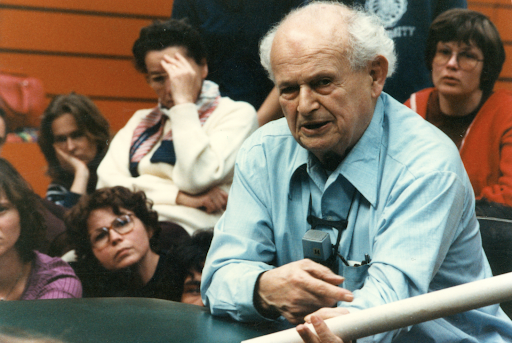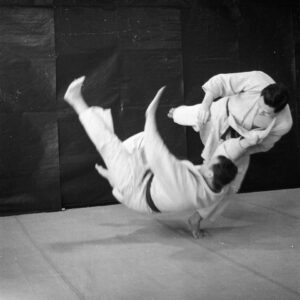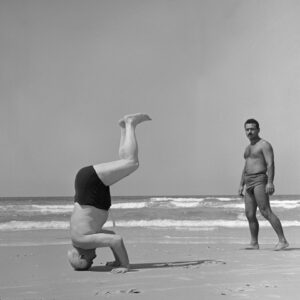
Early Years and Knee Injury
Moshe Pinchas Feldenkrais, educator and explorer of humankind, was born on May 6, 1904, in Slavuta, in the present-day Ukraine. He moved with his family to Baranovich (now in Belarus) in 1912, where he attended school, learned Hebrew, and received his Bar Mitzvah under the difficult battle conditions of World War 1. At the end of the war, following the Balfour Declaration on the establishment of a Jewish state, Moshe, aged 13, left his family and embarked on a six-month journey to Palestine, arriving in December 1919. He knew already then that his education would be better served there.
Initially Feldenkrais worked as a laborer in the construction of Tel Aviv. At the age of 16, under the British Mandate in Palestine, Feldenkrais joined the Haganah, the Jewish self-defense organization, and after learning jujitsu, devised his own self-defense method which he taught to his fellow freedom fighters.
He soon enrolled at the Herzliya Hebrew Gymnasium (high school) in Tel Aviv, supporting himself by tutoring mathematics. After graduating from there in 1925, he worked as a cartographer for the British Mandatory Survey Office, making maps of Palestine, Egypt, and Syria.
In 1929 he badly injured his knee in a soccer match. Based on his experiences and learning during this period, he later wrote and self-published a manual on self-defense, Jiujitsu and Self Defense (1931). He also read and translated into Hebrew The Practice of Autosuggestion by CH Brooks. This important work, to which he added two chapters, is about the power of conscious self-suggestion and self-hypnosis to improve any condition, mental or physical. He cared about his hard-working and fighting friends and understood that they needed not only to be physically fit, but that their mental state was critical to their ability to survive.
Moshe in Europe and Meeting Jigoro Kano, Founder of Judo
Feldenkrais left Palestine and traveled to France in 1930 and enrolled in the École Spéciale des Travaux Publics, a famous engineering school in Paris, graduating in 1933. Later on he began working as a research assistant in the laboratories of Joliot-Curie at the Radium Institute in Paris while studying for his doctorate in engineering at the Sorbonne. Because of the war he did not receive his doctoral degree until the end of 1945.
 His earlier interest in jujitsu brought him into contact with Jigoro Kano, the founder of judo, whom he met in Paris in 1933. This seminal meeting led Feldenkrais to start judo training and he went on to receive his black belt. Kano was impressed by Feldenkrais’ skill and knowledge and wanted him to be the conduit for introducing judo to France. Meeting Kano and judo embarked Feldenkrais on his life-long development of what became the Feldenkrais Method.
His earlier interest in jujitsu brought him into contact with Jigoro Kano, the founder of judo, whom he met in Paris in 1933. This seminal meeting led Feldenkrais to start judo training and he went on to receive his black belt. Kano was impressed by Feldenkrais’ skill and knowledge and wanted him to be the conduit for introducing judo to France. Meeting Kano and judo embarked Feldenkrais on his life-long development of what became the Feldenkrais Method.
While in Paris in 1938, Feldenkrais married Yona Rubenstein, a renowned pediatrician, who he got to know during his childhood and later in Tel Aviv when they both attended Herzliya Gymnasium. Yona had what was known as a congenital hip displacement (developmental dysplasia), and Feldenkrais used his skills and knowledge to help her regain better function (Reese 2015). Though they were only married for ten years, they remained lifelong friends.
Escaping the Nazi advance on Paris in 1940, the couple fled to Britain, although not empty-handed. Feldenkrais carried with him heavy suitcases of secret documents connected to radiation research in Paris, which he took to the British Admiralty. Later on it was discovered that the documents contained, among other things, instructions on how to make phosphorus bombs. He was taken on as a scientific officer in the Admiralty, for whom he subsequently conducted anti-submarine research in Scotland from 1940 until the end of the war. He also re-injured his knee during his hurried escape from France and while walking on submarine decks.
Moshe’s books published
During this period, Feldenkrais taught judo and self-defense classes which led him to publish Judo – the Art of Defense and Attack, and Practical Unarmed Combat.
But plagued again by his knee injury and with no viable prospects for surgery, he became bedridden and began working in earnest to heal himself. By carefully observing the functioning of his knee and its relationship to the rest of his body through gentle movement and self-awareness, he began to develop a non-invasive system of movement and reeducation that helped him overcome his injury. He wrote and gave lectures about his new ideas, began to teach experimental classes, and worked privately with colleagues. These lectures became the source of his next book, Body and Mature Behavior.
Feldenkrais remained in the UK after the war, moving to London in 1946, where he worked as a teacher and inventor, relying also on loans from friends. He took judo classes with Gunji Koizumi at the London Budokwai, sat on the international judo committee, and analyzed judo principles scientifically. He spent much time writing during these years (1947-48) and published his first full book on his method, Body and Mature Behavior, in 1949, and his final book on judo, Higher Judo, in 1952. During this period, he also studied and was influenced by the works of George Gurdjieff, FM Alexander, William Bates and Heinrich Jacoby.
Moshe begins the formal teaching of his Method
 In February 1949 Moshe became a British citizen. He returned to Israel in September 1950 to direct the Israeli Army Department of Electronics. Around 1954 he moved permanently to Tel Aviv and, for the first time, made his living solely by teaching his method. He worked on the manuscript for The Potent Self which he had begun in London in 1947 but which was not published until 1985, after his death. In this seminal work, Feldenkrais delves into the relationship between faulty posture, pain, and the underlying emotional mechanisms that lead to compulsive and dependent human behavior, and his vision of how to achieve physical and mental wellness through the development of authentic maturity.
In February 1949 Moshe became a British citizen. He returned to Israel in September 1950 to direct the Israeli Army Department of Electronics. Around 1954 he moved permanently to Tel Aviv and, for the first time, made his living solely by teaching his method. He worked on the manuscript for The Potent Self which he had begun in London in 1947 but which was not published until 1985, after his death. In this seminal work, Feldenkrais delves into the relationship between faulty posture, pain, and the underlying emotional mechanisms that lead to compulsive and dependent human behavior, and his vision of how to achieve physical and mental wellness through the development of authentic maturity.
It was about a year later that Feldenkrais permanently located what he was now calling his Awareness Through Movement® classes to a studio on Alexander Yanai Street in Tel Aviv. In 1956, he began giving lessons to Israeli Prime Minister David Ben-Gurion. As a result of his lessons with Feldenkrais, Ben-Gurion learned how to do a headstand, aged 71.
Moshe teaching in Europe and the United States
Feldenkrais presented his work in Europe and the United States in the mid-1960s, publishing Improving Ability – Theory and Practice (written originally in Hebrew and subsequently titled Awareness through Movement: Health Exercises for Personal Growth in its 1972 English language edition). In 1968, a studio on 51 Nachmani Street in Tel Aviv became the permanent site for his private Functional Integration® practice, and the location for his first teacher-training, which was given to a dozen students between 1969 and 1971.
After giving month-long training courses in his method internationally, Feldenkrais was invited to teach a large teacher-training program in San Francisco over four summers, starting in 1975. He also published Body Awareness as Healing Therapy: The Case of Nora (1977), a fascinating study of his work with Nora, a woman who suffered a severe stroke, losing her ability to read and write.
It was a sign of how popular his method was becoming that in 1980 he began the 235-student Amherst teacher-training course in Amherst, Massachusetts. Unfortunately, however, Feldenkrais only taught the first two summers of the four-year program. After the second summer of the Amherst training, while staying in Zurich with close friends, he suffered a subdural hematoma. Dr. Gazi Yasergil, a famous Turkish neurosurgeon and head of neurosurgery at the University of Zurich hospital, operated on him, suctioning out the old blood clot, probably acquired from his fighting days. When he was well enough, he returned to Tel Aviv. He recovered and continued to teach from his home but suffered several small strokes after that. His book, The Elusive Obvious, was published in 1981, the year he stopped teaching publicly. Moshe Feldenkrais died in Tel Aviv on July 1, 1984.
(from “The Feldenkrais Method, Learning Through Movement”, published by Handspring Press, 2021, edited by Staffan Elgelid and Chrish Kresge)
